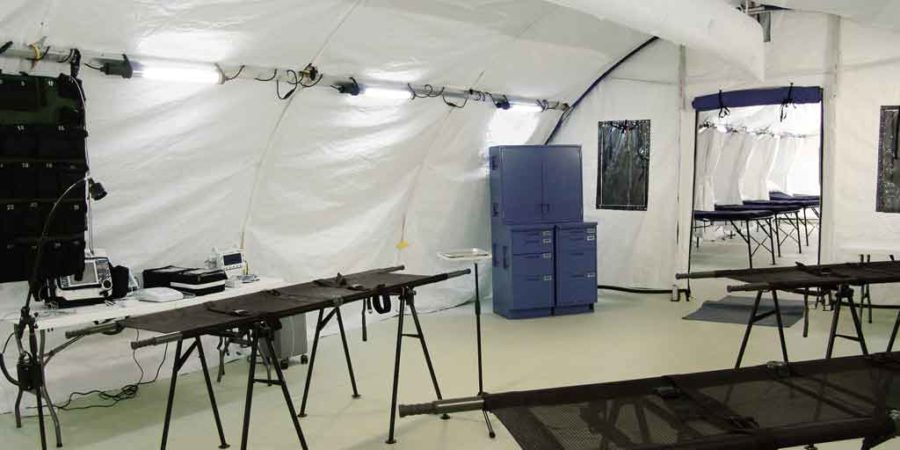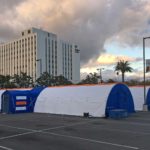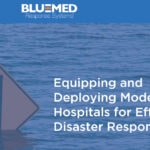How Triage Tents Help Manage Patient Surges
Triage tents have become essential recently due to patient surges stemming from the COVID-19 pandemic. Hospitals and clinics around the world have seen higher admission spikes than ever before. This puts immense pressure on healthcare systems to tend to those fighting the virus and provide proper patient screening shelters.
A new study released by the National Institutes of Health (NIH) suggests that one out of four deaths from COVID-19 is due to hospital strain from surging caseloads in U.S. hospitals. The study analyzed data pertaining to 150,000 patients from 558 hospitals between March and August of 2020. Their analysis revealed that more than half of those admissions arrived during peak COVID-19 surges.
“Surges were associated with mortality across ward, intensive care unit (ICU) and intubated patients,” says the NIH.
And while hospitals seemed to have some relief in the spring of 2021 as more Americans got vaccinated and inpatient numbers declined, the spread of the virus only remained relatively under control for a short period of time. Then variants such as Delta ravaged communities, causing even higher spikes than last year.
In order to help in the fight against the COVID-19 virus, triage tents are becoming increasingly popular solutions for patient screening issues and determining the severity of individual patient needs.
[Related: Guide to Creating Space for Medical Surge]
The Importance of Triage Tents
Hospitals often use triage tents to keep ill and infected patients separated from healthier ones when surges peak. Staff can provide patient screening shelters in these portable medical tents before admitting them to determine the severity of their case and if they need immediate care.
A patient screening process is essential in preventing new patients from the potential contraction of COVID-19 in the hospital’s main facility. It also creates a hierarchy for admittance and immediate treatment based on the specific needs of an incoming patient.
The ability to screen patients before admittance helps hospitals remain in control when their system is over capacity. Additionally, triage benefits community members by preventing further contraction of COVID-19. This is especially important for older or at-risk individuals currently receiving treatment for reasons unrelated to the virus.
The extra space provided by triage tents is also helpful when administering COVID-19 walk-ups or administering vaccines, and sometimes even treating ill individuals that may need immediate care when beds and amenities are scarce in the main facility.
Medical facilities only have so much space and have to adhere to capacity regulations. As a result, triage tents are a vital tool for quickly expanding capacity and caring for the ill.
[Related: Medical Shelters for Temporary Vaccination Sites]
How Triage Tents Help
Triage tents are exceptionally useful to fall back on when capacities are on the verge of capping during hospital surges, but they’re also great at providing a level of preparedness before spikes happen.
The process of purchasing and delivery, assembling and installing, stocking the tents with medical supplies, and finally admitting patients can take a number of days to plan and prepare. When each day makes a difference in potentially saving lives, it’s smartest to have everything on-hand before a hospital reaches capacity.
If hospitals assemble, install, and equip triage tents prior to surges, the tents will be readily available to lessen the burden on hospitals and staff. Hospitals will even be able to start triaging patients before reaching capacity.
This better prepares hospital staff for the surge and makes the flow of care in the main facility more efficient. What’s more, triage keeps hospital rooms available for those needing immediate and life-saving treatments.
[Related: Key Elements of Pandemic-Ready Healthcare Facilities]
Triage Tent Design Considerations
Finding Space for Triage Tents
Determine if your organization has enough space to accommodate a triage tent. Are there lawns or parking lots near the main building or within property boundaries that could accommodate a triage tent? What about areas outside the hospital’s emergency department that could be ideal for a triage tent?
Determining potential sites for the installation of triage tents ahead of time will save you from seeking last-minute and lengthy approval processes. What’s more, this preparation will help hospitals meet safety regulations to protect staff, medical equipment, and incoming patients.
Staffing Triage Tents
It’s important to have an appropriate amount of staff in each triage tent to screen patients before admittance. Personnel needed are typically admission staff, nurses, and physicians or providers.
Triage tents are a great solution for keeping ill or infected patients separate from potentially healthier incoming patients, and vice versa. Patient screening shelters can assist with determining how best to separate healthy and infected patients. Typically, when hospitals put triage tents in place, they are often close to or already past the point of capacity. This generally means that limited medical staff is available. For this reason, it is important to designate and train a team of personnel to set up the triage tents. Additionally, periodic exercises are beneficial for practice purposes.
Hospitals can always put triage tents in place. Nevertheless, ensuring professionals are there to screen and serve the community is vital to their purpose.
Supplies for Triage Tents
Consider the number of administration supplies you will need during the triage process. Chairs (and sometimes beds) are necessary for waiting areas, and having medical equipment on hand is advisable in case there’s an emergency.
Larger medical equipment — including respirators, vital sign machines, blood glucose monitors, and more — is sometimes necessary during the in-patient screening process. Relevant equipment should be readily available and conveniently on hand in each triage tent.
Containers and storage solutions are also essential in order to hold various medical tools and supplies, such as disposable stethoscopes, nasal swabs, isolation gowns, masks, hand sanitizer, gloves, eye protection, and even garbage.
The Benefits of BLU-MED Structures for Triage Tents
BLU-MED Response Systems® is the world’s leader in deployable medical facilities, including triage tents. Mobile field hospitals and medical shelters from BLU-MED are a scalable solution for when hospitals reach or are close to reaching capacity. Our portable medical shelters can be rapidly set up on your organization’s grounds for creating additional administration, supply storage, and in-patient spaces such as waiting areas, patient screening shelters and triage centers to host those needing care.
BLU-MED’s mobile medical facilities can be equipped with a large assortment of medical equipment to provide advanced levels of care, including:
- Operating rooms (OR)
- Emergency rooms (ER)
- Negative pressure isolation and treatment facilities for COVID-19 and other infectious airborne diseases
- Trauma centers
- Emergency operation centers (EOC)
Durable
BLU-MED medical shelters utilize a high-strength frame system and tensioned fabric membrane. Our weatherproof shelters are engineered and tested to meet specific wind and snow loads for safety and durability, allowing them to be used year-round and in areas with torrential rains, intense winds, and large amounts of snow.
Climate-Controlled Medical Shelters
Our medical shelters can be equipped with insulation and climate-control systems to maintain a safe and comfortable environment for patients and healthcare workers to provide advanced levels of care in extreme temperatures.
Rapidly Deployable Medical Shelters
Medical shelter systems from BLU-MED feature low-cube packaging, allowing them to be easily transported when and where needed™. Our rapidly deployable medical shelters allow organizations, hospitals, and response agencies to quickly deliver and establish triage tents and other medical facilities on virtually any type of level surface. As the medical needs change, the triage tent can easily be taken down, relocated, or stored for future surge events.
Scalable and Modular Medical Facilities
Depending on the severity of the surge, our modular medical facilities can be configured with open-air designs for walk-up needs to prevent the spread of disease with ample airflow. And by design, our medical fabric shelters feature unmatched expansion capabilities. This allows your organization to quickly (and easily) accommodate rising numbers of patients.
Tested and Proven
BLU-MED’s mobile hospital solutions are designed to meet the U.S. military’s exacting standards and have been proven in combat operations and extreme climates around the globe. In addition, we have experience creating rapidly deployable military shelter systems for mid-to-long-term operations in harsh and remote locations.
The Best Deployable Medical Shelters for Triage Tents
Hospitals can use and configure BLU-MED’s deployable medical shelters in a variety of ways. BLU-MED offers systems ranging from 10-bed medical shelters to as large as 300-bed field hospitals.
Medical Fabric Shelters
BLU-MED’s medical fabric shelters are great solutions for triage tents. They feature expansion capabilities and the modular, open span design allows for spacious interiors to accommodate hospital staff, medical equipment, and additional patients during a surge event. You can custom-design your medical fabric shelter for walk-ins and larger ones can accommodate screening, testing, and vaccination services.
The BLU-MED Module 2S is a medical fabric shelter system that features an entry vestibule for admitting patients, and military-grade HVAC systems. The Module 2S system consists of two medical fabric shelters, joined to create an additional 1,500 square feet of space.
The BLU-MED Module 4S is twice the size of the Module 2S, providing an additional 3,000 square feet of space. This facility consists of four medical fabric shelters, an entry and connecting vestibule, as well as ruggedized HVAC systems.
If you’re in need of a much larger medical facility or a small field hospital, the BLU-MED Module 6S consists of six medical fabric shelters, providing an additional 4,500 square feet of space. Similar to the Module 2S and Module 4S models, the Module 6S includes entry and connecting vestibules, as well as portable HVAC systems.
Our multi-purpose medical shelters allow organizations to quickly establish a clean, safe space for life-saving treatments during hospital surges.
[Related: Helpful Ways to Use Hospital Surge Facilities After the Pandemic]
Immunization Facilities
BLU-MED’s immunization facilities have areas for administration, patient processing, patient waiting, patient screening and immunization areas to vaccinate patients for viruses such as COVID-19.
Waiting areas can serve for patients coming in for an appointment, or even after vaccinations when a 15-minute time frame is typically necessary while waiting for possible adverse reactions.
Laboratories
Hospitals can easily configure and use BLU-MED medical shelters for laboratories and equip them with autoclaves, workbenches, centrifuges, hood areas, and mass spectrometers to facilitate testing or documenting test results. This is especially useful during pandemics since triage tents often serve as space for rapid testing. On-site laboratories allow for the immediate processing of test results for patients concerned about contraction.
[Related: The Importance of Mobile Field Hospitals During the COVID-19 Pandemic]
Additional Products for Triage Tents
Isolation Partitions
Isolation partitions are available to add to any BLU-MED medical shelter. These are important components for creating negative pressure spaces to quarantine infected patients.
In addition to isolation partitions, BLU-MED also offers privacy curtains.
Environmental Control Units (ECUs)
Our ECUs create a more comfortable environment for staff and patients with their heating and cooling capabilities. BLU-MED uses the Alaska ECU™, a military-grade HVAC system that can be added to any of our facilities.
Our ECUs are portable and available in either U.S. 60 Hertz or EU 50 hertz electrical components. You can choose from a range of sizes and models to fit the needs of your medical facility.
[Related: COVID-19 Vaccinations Can Prevent Hospital Surges]
Deployable Triage Tents Help Manage Patient Surges
BLU-MED’s mobile field hospitals and medical shelters provide the extra space your organization needs when you reach capacity.
To learn more about BLU-MED or our mobile field hospitals and medical shelters, call +1-425-739-2795, email inforeq@blu-med.com, or fill out the online inquiry form on our contact page.


